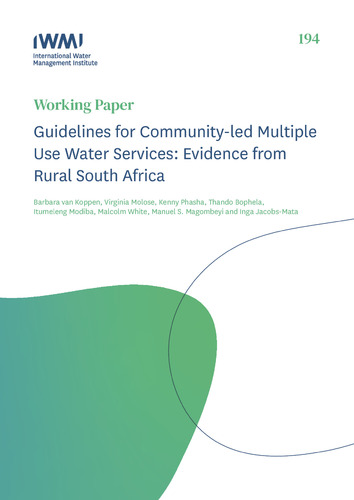Guidelines for community-led multiple use water services: evidence from rural South Africa
Abstract
The African Water Facility, together with the Water Research Commission, South Africa, as its implementing agent, supported the demonstration project Operationalizing community-led Multiple Use water Services (MUS) in South Africa. As knowledge broker and research partner in this project, the International Water Management Institute (IWMI) analyzed processes and impacts at the local level, where the nongovernmental organization Tsogang Water and Sanitation demonstrated community-led MUS in six diverse rural communities in two of the poorest districts of South Africa, Sekhukhune and Vhembe districts - Ga Mokgotho, Ga Moela and Phiring in the Sekhukhune District Municipality, and Tshakhuma, Khalavha and Ha Gumbu in Vhembe District Municipality. In conventional water infrastructure projects, external state or non-state agencies plan, diagnose, design and prioritize solutions, mobilize funding, and implement the procurement of materials, recruitment of workers and construction. However, this MUS project facilitated decision-making by communities, and provided technical and institutional advice and capacity development. Based on IWMI’s evidence, tools and manuals, the project team organized learning alliances and policy dialogues from municipal to national level on the replication of community-led MUS by water services authorities; government departments of water, agriculture, and others; employment generation programs; climate and disaster management; and corporate social responsibility initiatives.
This working paper synthesizes the lessons learned about the six steps of the community-led MUS process in all six communities. The step-wise process appeared to be welcome and effective across the board. The duration of the process and the costs of facilitation, technical and institutional capacity development, and engineering advice and quality control were comparable to conventional approaches. However, the respective responsibilities of the government and communities, also in longer-term co-management arrangements, depended on the type of infrastructure. Some communities were supported to improve their communal self supply systems. In other communities, the process enabled an extension of the reticulation of borehole systems owned, operated and maintained by municipalities. Almost all households used water supplies at homesteads for multiple purposes, underscoring synergies in cross-sectoral collaboration between the water, sanitation and hygiene (WASH) and irrigation sectors.

